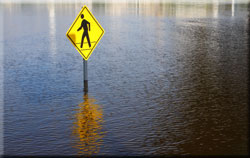There are many areas around the country that are having major problems with flooding. The rising flood levels in the Midwest have been a popular topic in the news recently. This news story reports that 1,000 residents of a southern Missouri town were forced to evacuate due to heavy rains and saturated grounds that could potentially cause a catastrophic failure of a levee along the Black River. Many others, living in flood-prone parts of the Midwest are packing up and heading for higher ground.
It's times like this that serve as a great reminder of the importance of having an Emergency Kit that is easy to grab if you are just given minutes to evacuate your home. A little bit of planning before you are asked to leave can make a very stressful situation much easier to handle.
Here are some tips on how to prepare for possible flooding. These are especially important if you live in an area that is prone to flooding.
Before a Flood
• Keep a battery-powered radio tuned to a local station, and follow emergency instructions.
• If the waters start to rise inside your house before you have evacuated, retreat to the second floor, the attic, and if necessary, the roof. Take dry clothing, a flashlight and a portable radio with you. Then, wait for help. Don't try to swim to safety; wait for rescuers to come to you

Buy Flood Insurance
• One of the most import things you can do to financially protect your home and family before a flood is to purchase a flood insurance policy.
• You can obtain one through your insurance company or agent. Flood insurance is guaranteed through the National Flood Insurance Program (NFIP), administered by the Federal Emergency Management Agency. Your homeowners insurance does not cover flood damage.
• Don't wait until a flood is coming to purchase your policy. It normally takes 30 days after purchase for a flood insurance policy to go into effect.
If time permits, here are some other steps that you can take before the flood waters come:
• Turn off all utilities at the main power switch and close the main gas valve if evacuation appears necessary.
• Move valuables, such as papers, electronics, jewelry, and family heirlooms to upper floors or higher elevations.
• Fill bathtubs, sinks and plastic soda bottles with clean water. Sanitize the sinks and tubs first by using bleach. Rinse, then fill with clean water.
• Bring outdoor possessions, such as lawn furniture, grills and trash cans inside, or tie them down securely.


4 comments
norriscal
These are all great ideas! I did not even think to sanitize my sinks and bathtubs. Where we live we sometimes have to fill the bathtub with water so we can flush the toilet. Next time I will sanitize it just in case I need to use it for consumption.
Jonna
We also purchased a small inflatable boat that we could put kids or gear in depending on the situation. Thanks for all the prep tips, we REALLY appreciate it!
ZOD
If you are able to. Get a small cheap jon boat or a cannoe. This will allow you to move with your BOB if a flash flood occurs and you cannot drive out. Put life jackets for the whole family and an extra or two for neighbors. If you are in a serious flood plain this could save you.
Cray
What about sandbags? Should we fight to keep the waters at bay for as long as we can? Are they worth the money and effort? I was talking to my wife about this the other day, we are moving to hurricane country, and I wasn't sure if I should add it to my prep list or not. Seems like it would be a good idea, but maybe futile at best?